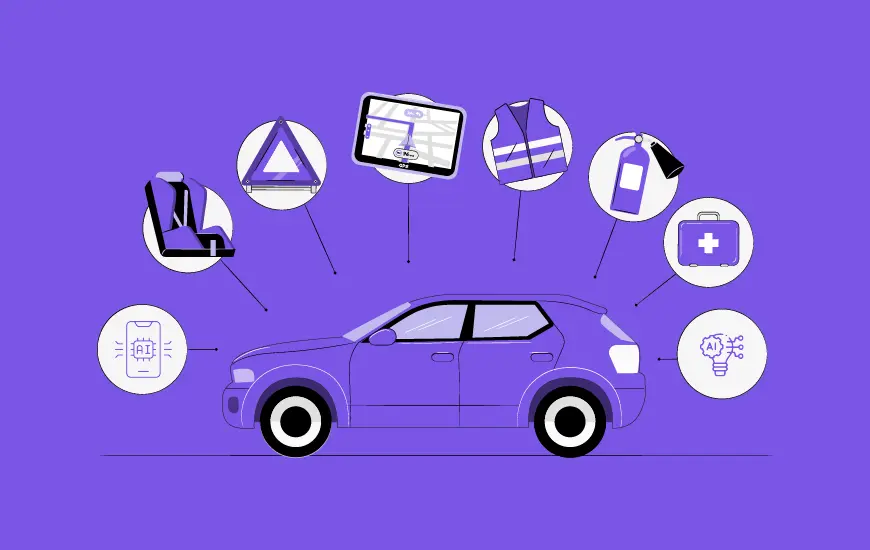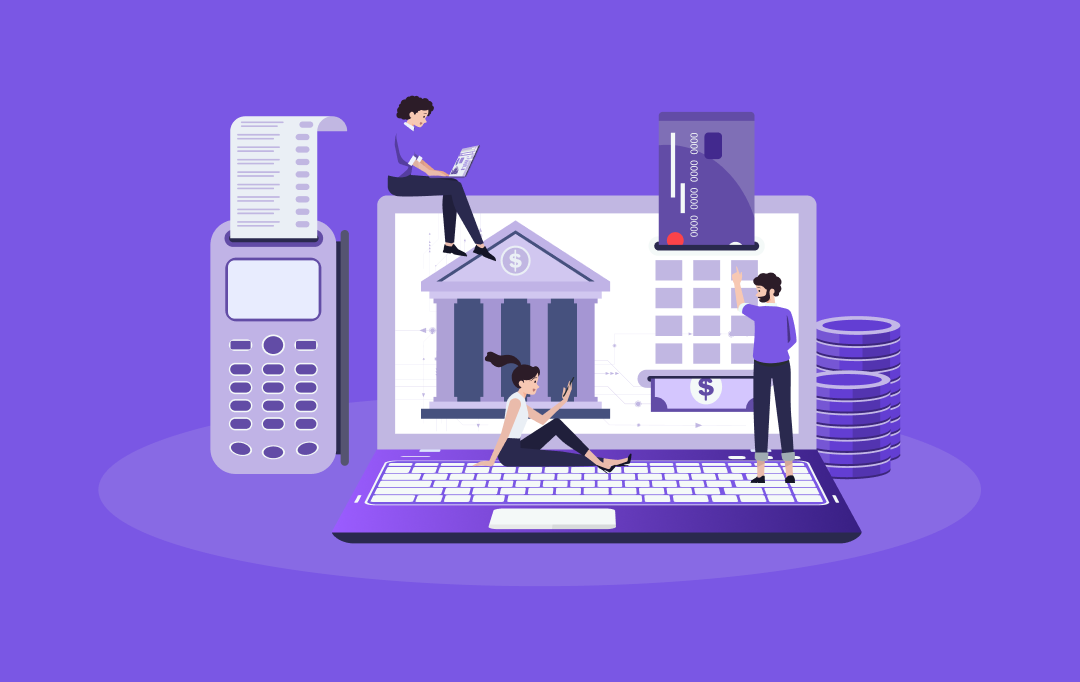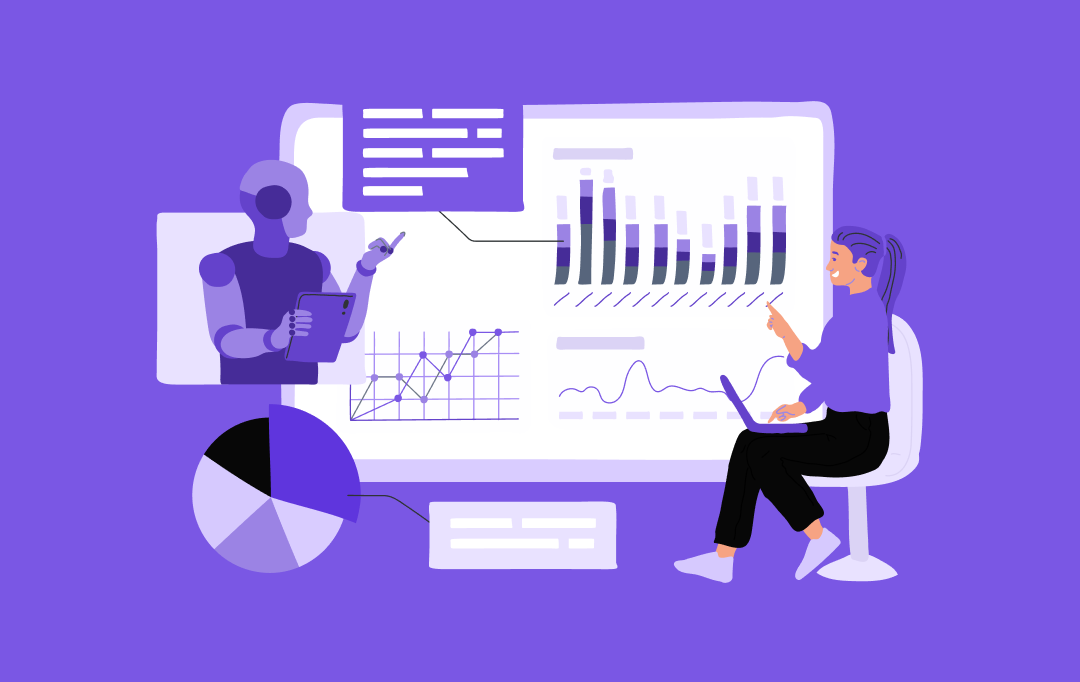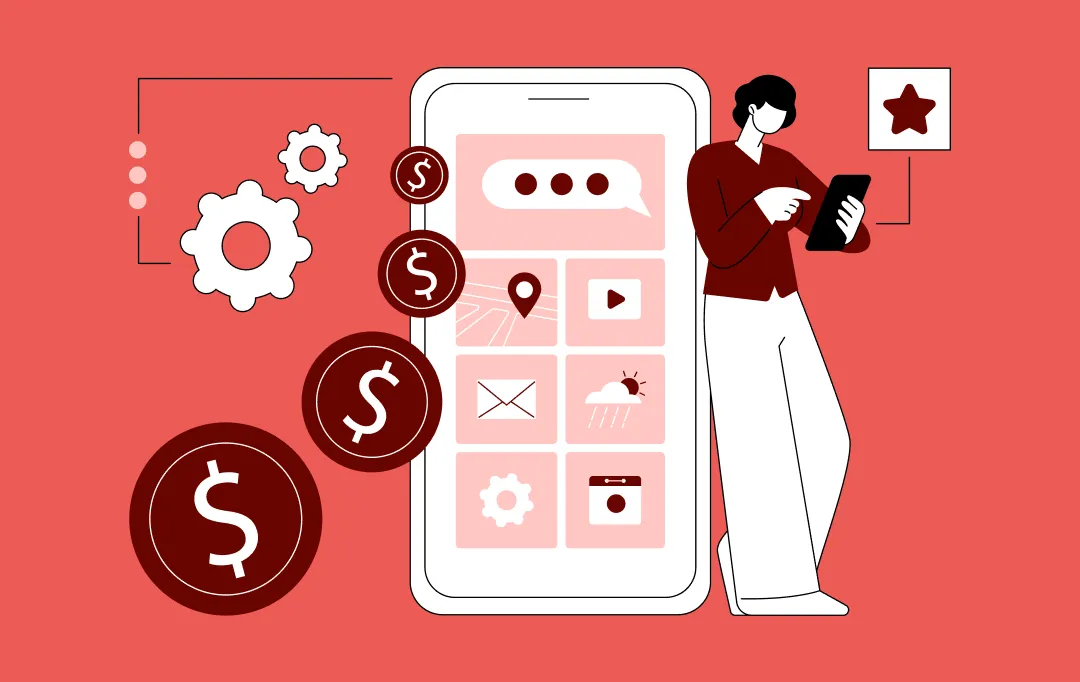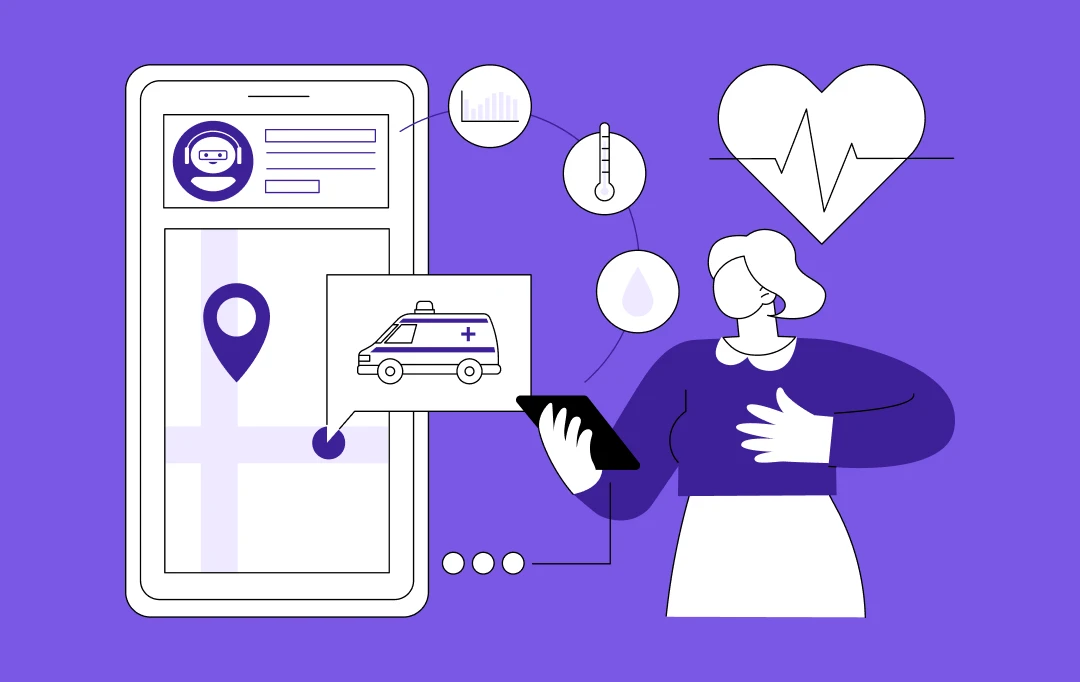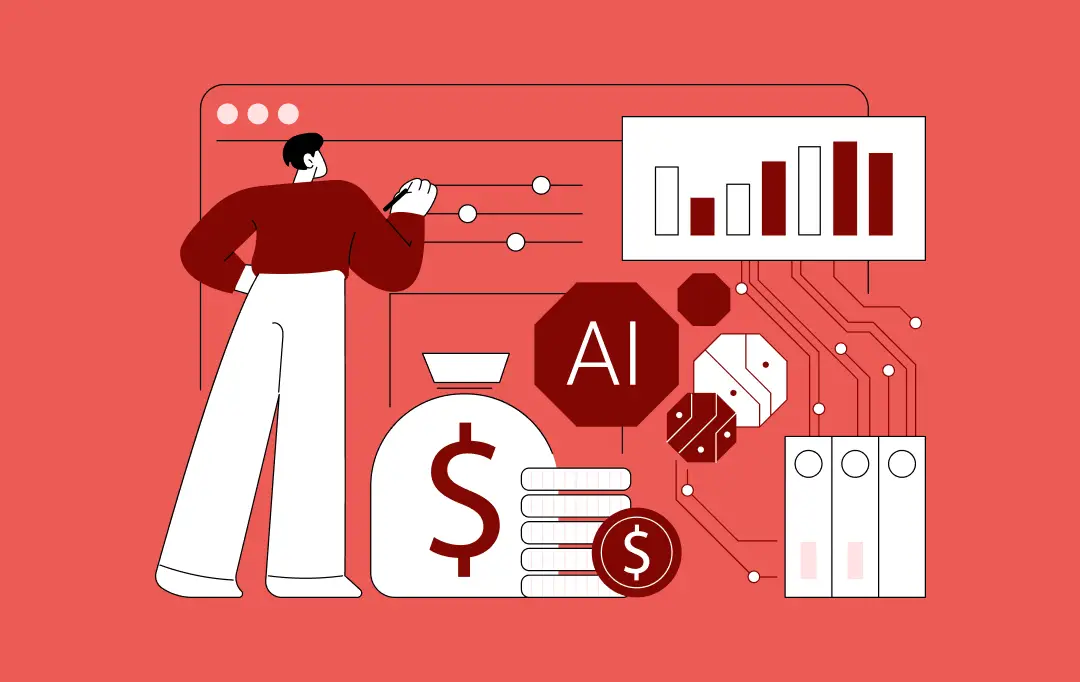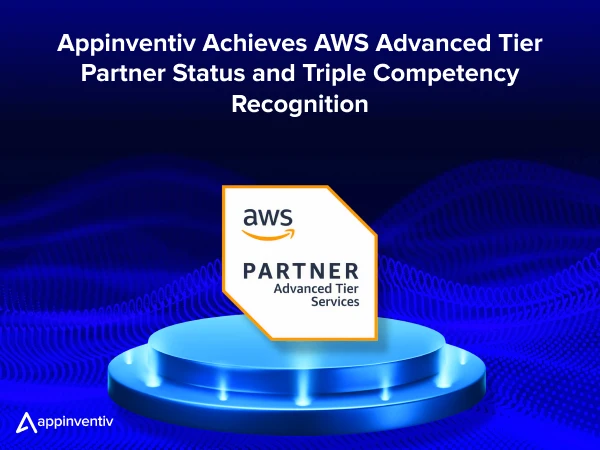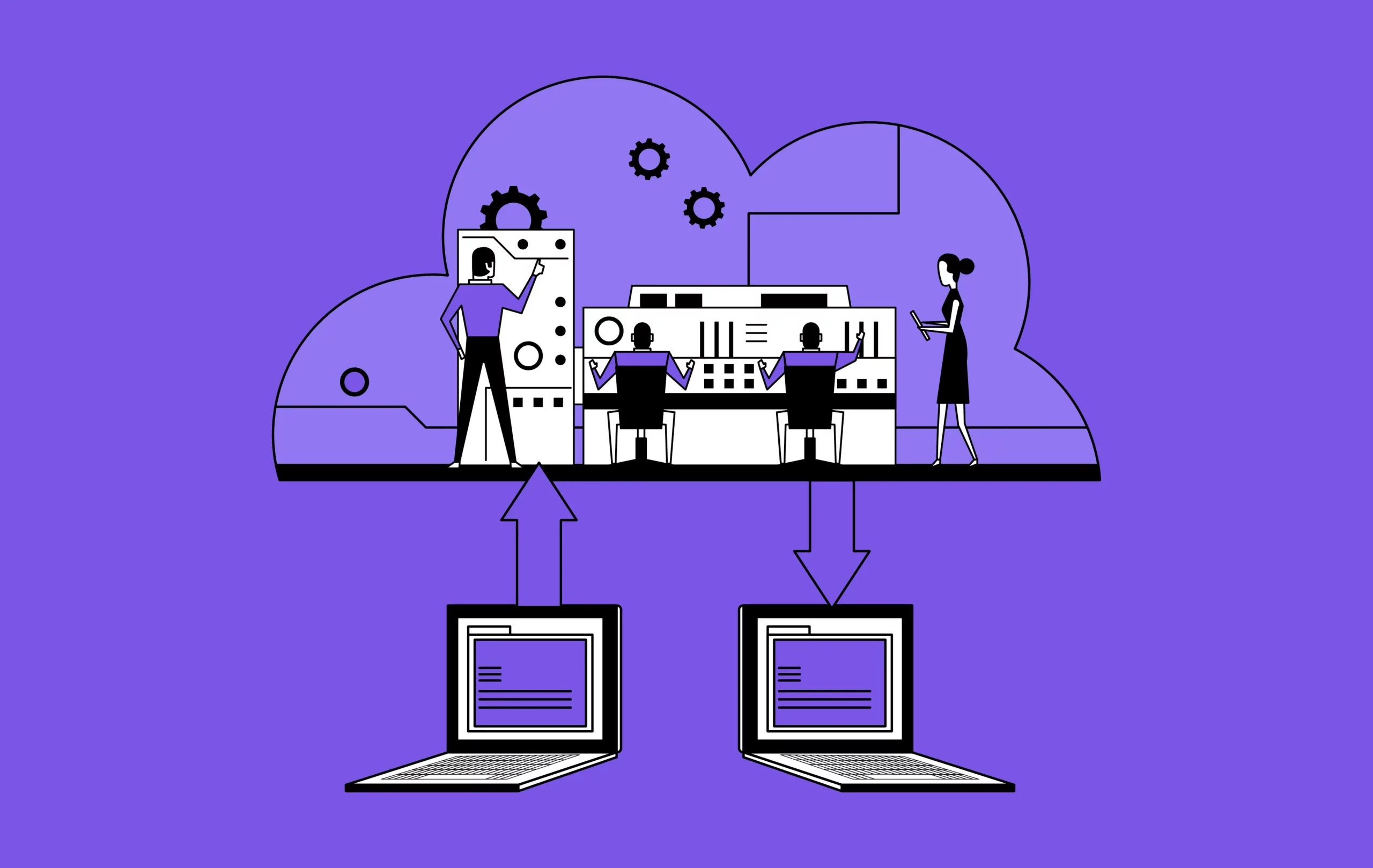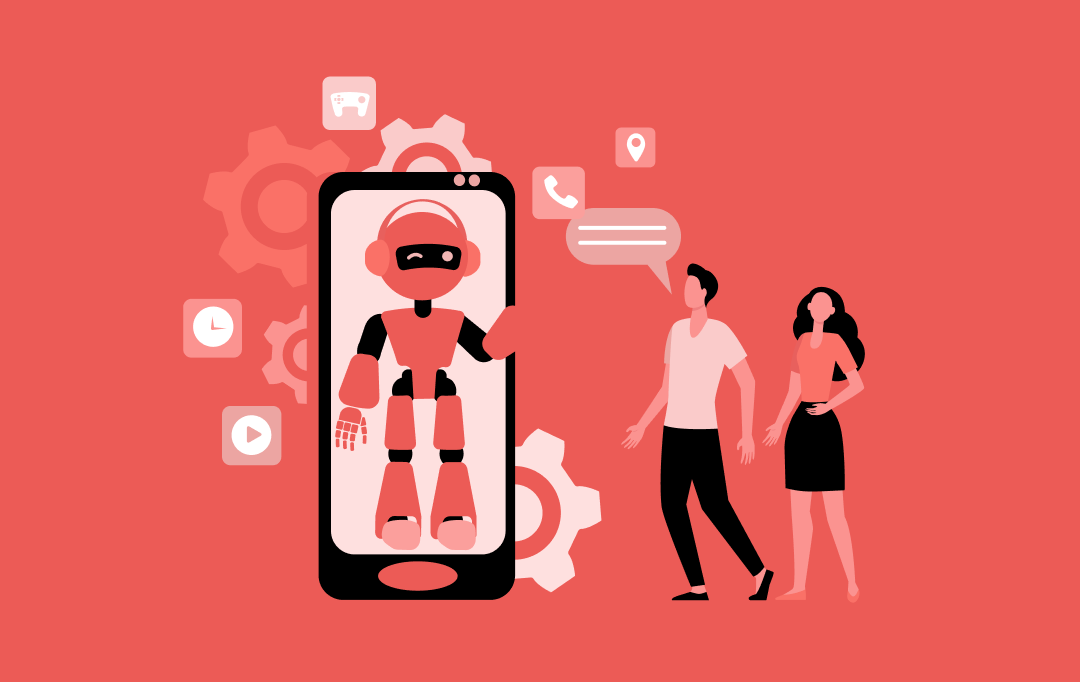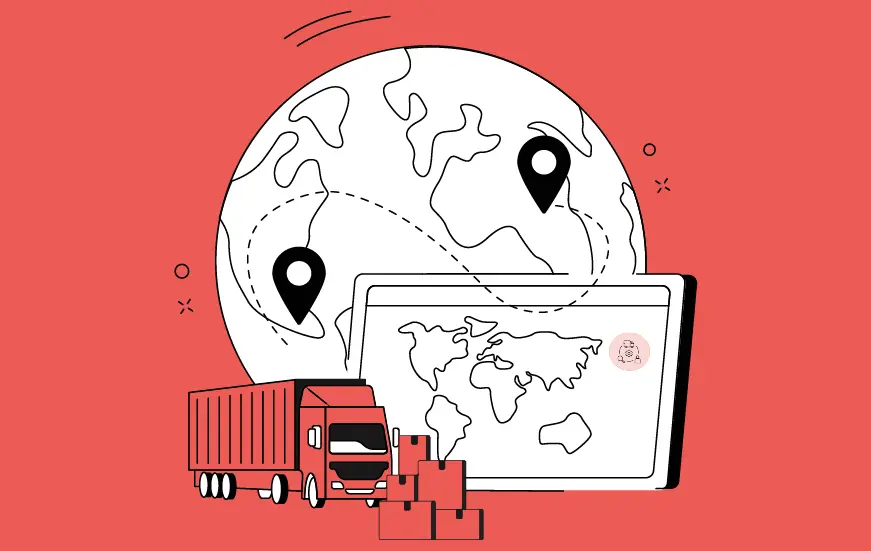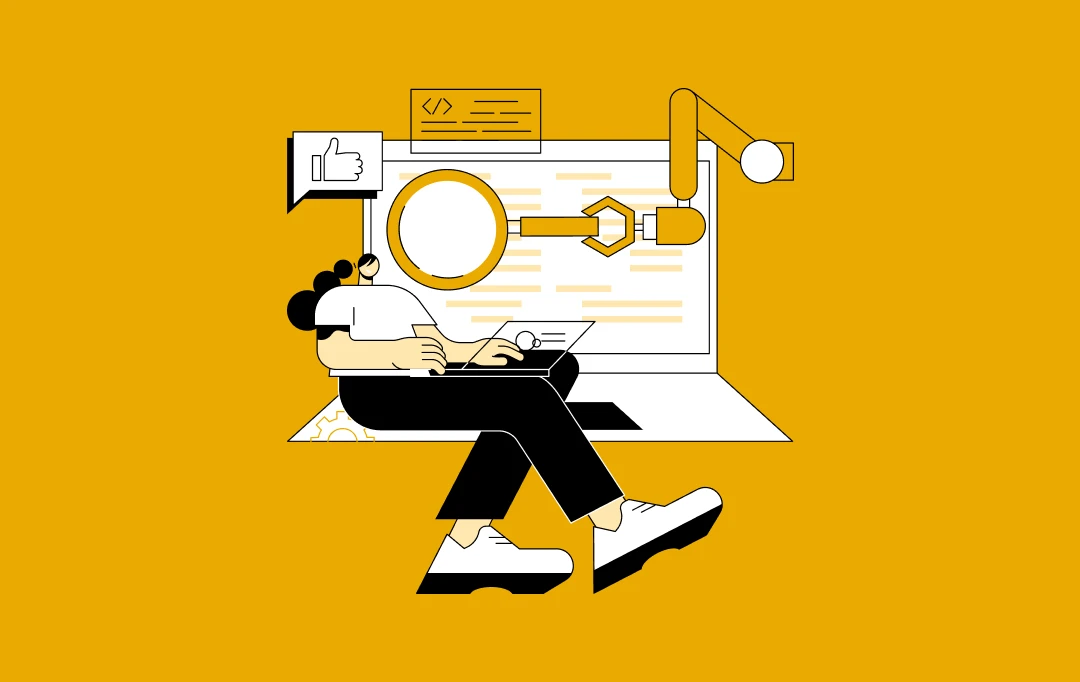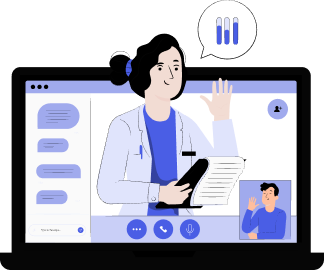- The Rise of Telemedicine Apps: A Booming Market
- How Much Does the Telemedicine App Development Cost?
- Factors Affecting the Telemedicine App Development Cost
- Feature List
- App Platform
- App Development
- Location of the Telemedicine App Development Company
- Team Size
- Maintenance
- Tech Stack
- Unseen Expenses in Telemedicine App Development
- Continuous Maintenance and Upgrades
- Cloud Hosting and Infrastructure Costs
- Marketing, Branding, and User Acquisition
- Regulatory Compliance and Licensing Fees
- Developing an MVP: Optimizing the Cost of Telemedicine App Development
- Other Ways to Optimize Telemedicine App Development Costs
- Focus on Essential Features
- Leverage Cross-Platform Technologies
- Outsource to Cost-Effective Regions
- How to Develop a Telemedicine App
- Define Your Telemedicine App Goals & Features
- Research Market & Compliance
- Focus on the UI/UX Design
- Develop & Integrate Core Features
- Test the Application
- Deploy & Maintain
- Must-Have Features of Telemedicine Mobile Apps
- Registration
- Profile Management
- Search and Filters
- Video Conferencing
- Text Chats and Voice Calls
- Calendar
- Payments
- Notifications
- Advanced Capabilities That Elevate Telemedicine App Performance
- Multi-Language Support
- Remote Patient Monitoring & IoT Integration
- Electronic Health Records (EHR) Integration
- AI-powered Symptom Checker
- Cloud-Based Medical Record Storage
- e-Prescriptions & Pharmacy Integration
- Emergency Support & SOS Feature
- Teletherapy & Mental Health Support
- Insurance Integration & Claims Processing
- Family Member & Caregiver Access
- Virtual Waiting Room
- How to Monetize a Telemedicine App?
- Fees
- Subscription
- Advertisements
- How Can Appinventiv Help?
- FAQs
- Q. How to make a telemedicine app for doctors?
- Q. How much does it cost to develop a custom telemedicine app?
- Q. What are the basic inclusions in the MVP of a telemedicine app?
- Q. What are some top telemedicine app benefits for patients and healthcare organizations?
Key Takeaways
- A custom telemedicine app can cost anywhere from ~$40,000 to $100,000 for a basic version, up to $100,000-300,000+ for a feature-rich, complex solution.
- The final cost depends heavily on factors such as feature set, platform, team location, development hours, tech integrations, and compliance requirements.
- Beyond development, hidden or ongoing costs like cloud hosting, maintenance, regulatory compliance, and marketing/user acquisition must be budgeted from day one.
- Launching an MVP helps you validate your idea with essential features and control costs before scaling to the full-feature product.
- Strategic choices—such as focusing on essential features first, leveraging cross-platform frameworks, and engaging cost-effective development regions—can optimize cost without sacrificing quality.
When Teladoc Health launched its telemedicine platform, few anticipated that it would conduct 50 million virtual consultations in 2024 alone. (Source: Teladoc Health) The success of Teladoc, Amwell, and MDLIVE proves that digital healthcare isn’t just an emerging trend; it’s a fundamental shift in the industry.
A study suggests that 80% of patients preferred telehealth for prescription refills, 72% for reviewing medication options, 71% for discussing test results, and 57% for mental health visits. (Source: Forbes). Factors such as changing patient expectations, physician shortages, and advancements in AI and remote monitoring have fueled this rapid adoption. Additionally, government-backed reimbursement policies have solidified telemedicine’s role in modern healthcare.
For entrepreneurs and healthcare providers, the question is no longer why invest in telemedicine, but how much does it cost to build a telemedicine app? Development expenses vary based on features, security, and integrations.
A basic telemedicine app may cost $40,000 to $100,000, while a feature-rich, AI-powered platform can range from $100,000 to $300,000+.
For healthcare providers looking to serve patients who need immediate attention without emergency room visits, the decision to develop an urgent care app represents a practical solution that bridges the gap between scheduled appointments and emergency services.
In this guide, we’ll delve into cost factors, hidden expenses, and strategies for cost optimization, along with key monetization considerations for launching a successful telemedicine platform—empowering you to navigate the future of digital healthcare confidently.
Before diving into the various aspects of telemedicine app development costs, let’s first explore the rapidly growing market and the key players you’ll be competing with.
The Rise of Telemedicine Apps: A Booming Market
What was once considered a backup option for in-person visits has now become a cornerstone of modern healthcare. Telemedicine apps are not just filling gaps in accessibility. They are redefining how, when, and where people receive medical care. The industry has witnessed an unprecedented shift, with virtual healthcare evolving beyond basic video consultations to AI-powered medical diagnostics, remote patient monitoring, and personalized treatment plans.
The market’s growth is staggering. As per a report by Grand View Research, the global telemedicine market is expected to surpass $380.33 billion by 2030, driven by rising demand for instant, affordable, and specialist care. The future of telemedicine lies in advanced telehealth EHR integration that enables healthcare providers to access comprehensive patient histories during virtual consultations.
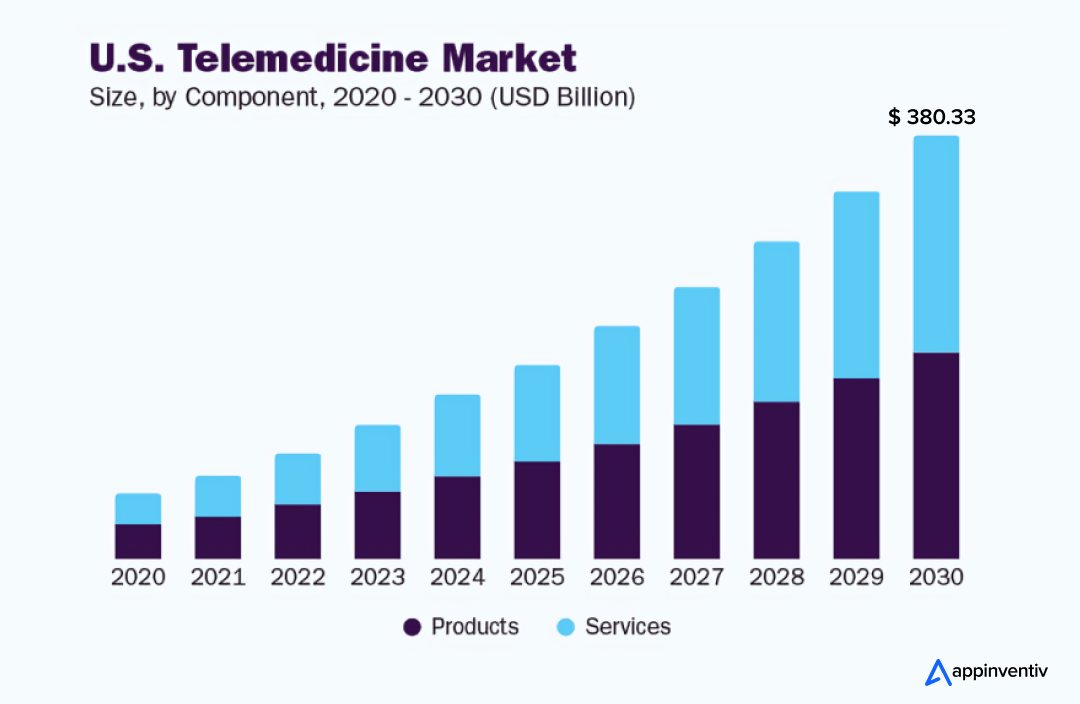
The push for hybrid healthcare models, where digital and in-person care work seamlessly together, further accelerates adoption. Meanwhile, insurance companies and healthcare systems are integrating telehealth into long-term care strategies, ensuring its permanence in the industry.
Beyond convenience, telemedicine addresses critical issues like physician shortages, chronic disease management, and healthcare costs. The next wave of growth will be fueled by AI, wearable tech, and real-time health analytics, making virtual healthcare not just an alternative but a preferred choice for millions. As innovation continues, businesses entering this space must focus on scalability, compliance, and user experience to stand out in this dynamic landscape.
How Much Does the Telemedicine App Development Cost?
For a general estimate, developing a custom telemedicine app can range from $40,000 to $300,000, depending on various factors such as app complexity, UI/UX design, prototyping, developer location and hourly rates, chosen platform, and feature set. The more advanced the app, the higher the development cost.
| App Type | Cost | Time Frame |
|---|---|---|
| Simple App | $40,000 to $70,000 | 2-3 Months |
| Medium Complex App | $70,000 to $100,000 | 3-6 Months |
| Highly Complex App | $100,000 to $300,000 | 9+ Months |
To help you understand the costs better, we have categorized the telemedicine apps based on their complexity and have included the time frame and costs of the development for the same.
Let us summarize the telemedicine app cost with an infallible formula:
Total Telemedicine App Development Cost = Total Number of Hours Taken to Complete App Development Processes X Hourly Rate of Developers
Now that you have a rough idea of the telemedicine app development cost, let us move ahead and discuss various factors that influence it.
Factors Affecting the Telemedicine App Development Cost
To apprehend the precise cost of a telemedicine app, you must understand the various factors that will affect it. Starting from an extensive feature list to the location and hourly development rates, the factors can influence the price of your app. Apprehending the factors logistically can help you make better monetary decisions while simultaneously alleviating the risks.
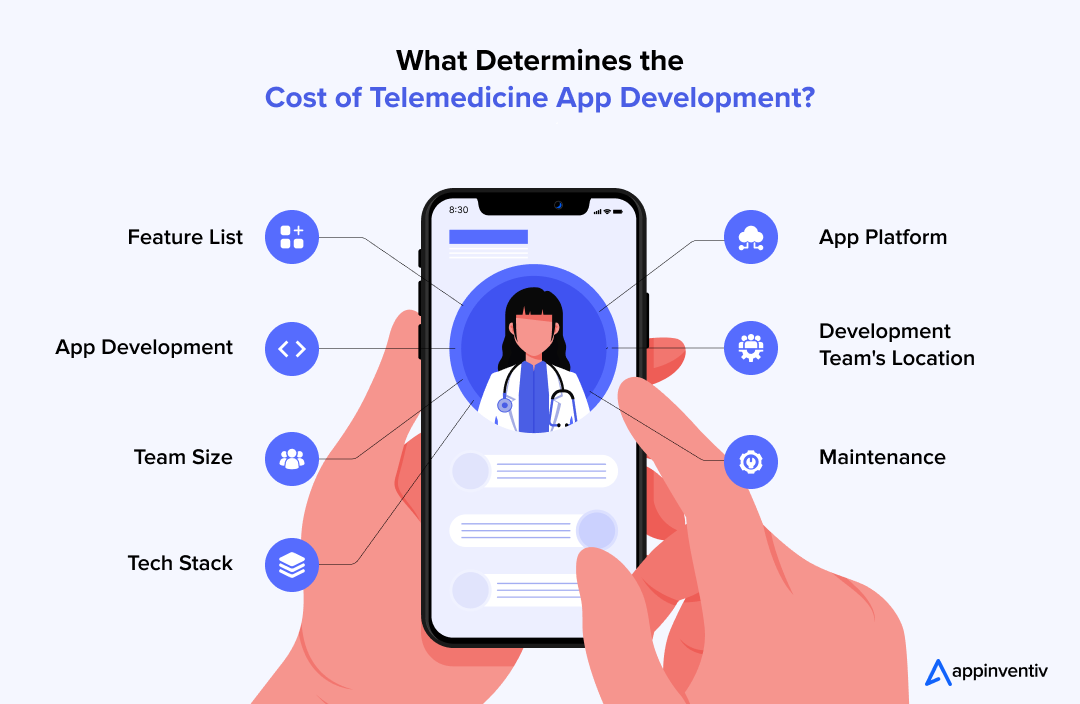
Feature List
The overall cost of a telemedicine app can be affected by the number of features it supports. For instance, a simple telemedicine app with a basic feature list and a nominal admin panel can cost you around $40,000 to $55,000. Increasing the number of telemedicine app features and functionalities can affect the overall gross price of telemedicine apps. Simply put, the more features integrated into the app, the more the cost associated with it.
A complex app with the highest functionalities and an extensive feature list can help put your business ahead in the digital space and will be worth all the investment.
App Platform
If you wish to develop a telemedicine platform for doctors, the underlying iOS or Android platform can affect its overall cost. The cost of developing an Android app is more than iOS, considering the former’s wide user base. To keep the budgets optimized, we usually recommend starting with a development for a single platform. As the app gains traction in the market, you can then switch to a cross-platform app custom to your requirements.
App Development
Telemedicine app development costs can be calculated based on the coding hours. The hourly rate of the developers, combined with the number of coding hours, can help you understand the development cost. In addition, the type of development team can also affect the overall cost of telemedicine software.
Here is a rough estimation of the telemedicine app development costs based on the type of team hired:
| Type of the Team | Estimated Telemedicine App Development Cost (Approx.) |
|---|---|
| In-House Team | $1500,000- $180,000 |
| Local App Development Company | $200,000- $230,000 |
| Outsourced App Development Company | $65,000- $80,000 |
| Freelancers | $35,000- $40,000 |
Analyzing the table can offer you a quick idea of how outsourcing a development team is your best option, considering an optimized budget. Outsourcing an experienced app development company can provide a full-fledged telemedicine app with multiple functionalities and a seamless interface.
Location of the Telemedicine App Development Company
The location of the hired healthcare application development team also influences the overall telemedicine app development costs. The table below will offer you a preliminary idea of the cost of development in various regions of the world:
| Development Region | Estimated Cost (Approx.) |
|---|---|
| US | $190,000- $250,000 |
| UK | $190,000- $200,000 |
| Australia | $150,000- $155,000 |
| Western Europe | $140,000- $160,000 |
| Eastern Europe | $70,000- $100,000 |
| Asia | $50,000- $300,000 |
Team Size
Another factor that influences the cost of telemedicine app development solutions is the team size of the hired company. A professional team comprising project managers, developers, designers, quality analysts, etc., with adequate experience can offer you a telemedicine app capable of standing out from competitors. Choosing a full-fledged development team can increase the cost of the app but will ensure a greater trajectory in your business.
Developing a white-label telemedicine app requires a team of:
- 1 Project Manager
- 2 Backend Developers
- 2 iOS/Android Telemedicine App Developers
- 1 Designer
- 1-2 Quality Analysts
Maintenance
The maintenance costs for an app can be compiled at the very last stage and added to the overall development cost. For instance, maintenance costs can include:
- Upgrading the app to support a new platform.
- Updating apps based on new requirements.
- Changing marketing trends.
For all the parameters that require maintenance, the cost varies per the telemedicine app development company hired on your end.
Tech Stack
The associated tech stack is an important factor that influences the overall telemedicine app cost. A robust tech stack that has the power to handle a large user base while offering them an optimum user experience is the need of the hour. Thus, the more technologies the app implements, the more the associated cost.
Now that you have gained insight into the various factors that affect the cost of telemedicine apps, let us analyze the unseen or hidden expenses involved in developing a telemedicine application.
Unseen Expenses in Telemedicine App Development
Developing a telemedicine app extends beyond initial design and coding; various hidden costs arise throughout its lifecycle that significantly impact the total investment. Awareness of these costs upfront helps businesses plan a sustainable budget and avoid unexpected financial crunches.
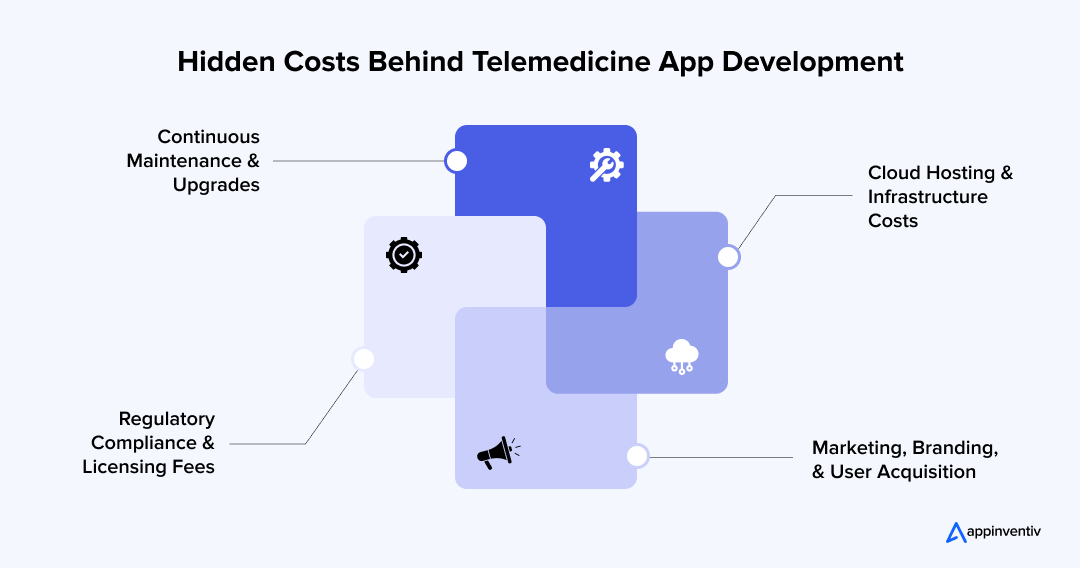
Continuous Maintenance and Upgrades
Maintaining a telemedicine app requires regular updates to fix bugs, enhance security, and introduce new telemedicine app features based on evolving user needs. As technology advances and healthcare regulations change, frequent updates ensure compliance and optimal performance.
Additionally, continuous monitoring, troubleshooting, and system optimizations are necessary to provide a seamless user experience, making maintenance a recurring and unavoidable expenses.
Cloud Hosting and Infrastructure Costs
Reliable hosting is crucial for a telemedicine app to function smoothly, ensuring high-speed performance, data security, and scalability. Cloud service providers like AWS, Google Cloud, or Microsoft Azure charge based on storage, bandwidth, and processing power, meaning costs can rise with increasing user traffic.
Additional expenses may include cybersecurity measures, data backups, and redundancy solutions to prevent downtime and protect sensitive patient information.
Marketing, Branding, and User Acquisition
Attracting users and gaining visibility in the crowded telehealth market requires a well-planned marketing strategy. This includes SEO efforts, paid advertising, influencer partnerships, and content marketing to reach potential patients and healthcare providers.
Beyond initial promotions, ongoing engagement through email campaigns, app updates, and loyalty programs is essential to retain users, making marketing an ongoing financial commitment.
Regulatory Compliance and Licensing Fees
Ensuring adherence to strict healthcare regulations like HIPAA, GDPR, and other regional laws involves substantial legal and licensing expenses. These costs cover compliance audits, security certifications, and legal consultations to prevent potential penalties.
Additionally, integrating third-party medical databases, e-prescription systems, and telecommunication services may require licensing fees, further adding to the overall expenditure.
Also Read: Why Telehealth Security is Non-Negotiable for Patient Trust and How to Achieve It
Developing an MVP: Optimizing the Cost of Telemedicine App Development
MVP for a telemedicine app is the app’s version with the most prominent features but doesn’t have all the advanced-level features. The basic idea behind opting for telemedicine app MVP development is to determine how multiple app users interact with your app and accept its overall concept. This will help you to get a clear idea of the audience before investing more money into scaling the MVP into a full-fledged application.
MVPs can allow you to have a good look at the app’s worth to your users without having to spend additional bucks. This is one of the most preferred ways for overall cost optimization of a telemedicine app.
Building an MVP gets you a working prototype of the app, which is test-ready. This development stage includes:
- A ready-to-implement design that includes all the key features
- The software architecture
- An app that real users can test
Let us look into the hours-wise breakdown of the time it usually takes to build the MVP of a telemedicine application.

Creating an MVP usually takes up to six weeks and costs a ballpark figure of $40,000 or more.
Once you have tested your MVP, it’s time to upgrade it into a full-fledged app. Here, the cost is dependent on several elements:
- App versions – doctor, patient, hospital, admin, etc.
- Deployment platform – mobile, desktop, both
- Technologies used – AI, Blockchain, IoT, etc.
- The complexity of the design
- The complexity of the feature-set
- The location of the development agency
A basic version of the application which consists of a simple design, no technology integration, mobile deployment, and three basic versions – a doctor app, a patient app, and an admin panel will cost you around $40,000 to $80,000.
If you decide to build a complex feature-heavy telemedicine application that has technological incorporation and is designed to support multiple features, the development costs can be around $150,000- 300,000. And the average development time can be between 3 to 12 months.
Other Ways to Optimize Telemedicine App Development Costs
Developing a telemedicine app demands a well-planned approach to manage costs effectively while maintaining high quality and regulatory compliance. Beyond launching an MVP, several other strategies can help businesses minimize expenses. Here’s how:
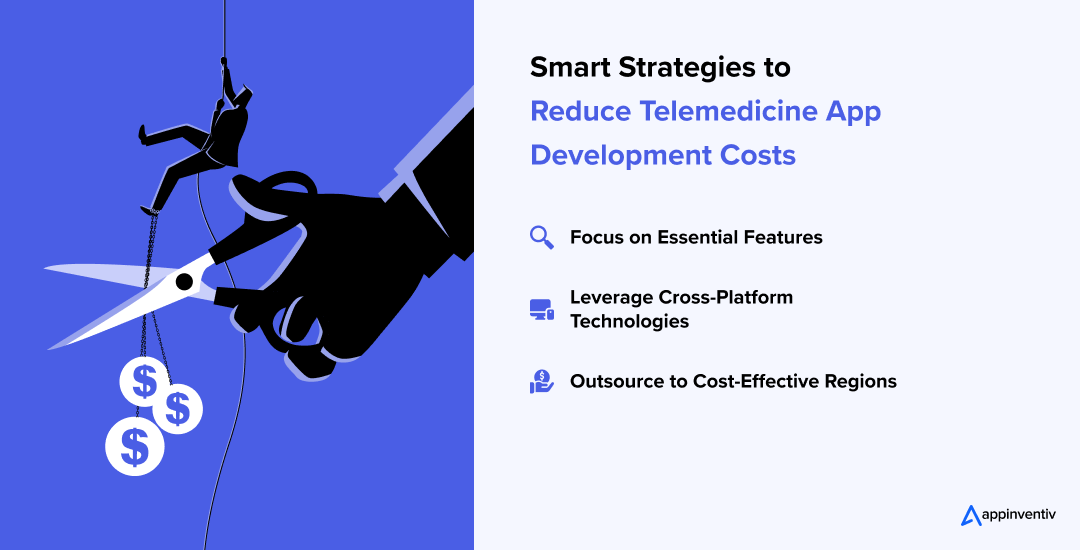
Focus on Essential Features
Avoid adding excessive functionalities that can drive up development costs. Prioritize must-have features such as video consultations, appointment scheduling, secure messaging, and payment integration. Advanced features can be introduced later based on user demand and business growth.
Leverage Cross-Platform Technologies
Developing separate native apps for iOS and Android can be costly. Using cross-platform frameworks like Flutter or React Native allows a single codebase to work across both platforms, reducing development time, maintenance efforts, and overall expenses while ensuring a smooth user experience.
Outsource to Cost-Effective Regions
Hiring an in-house team in high-cost regions can strain your budget. Outsourcing to experienced development teams in cost-effective areas like Eastern Europe, India, or Southeast Asia can offer high-quality results at a fraction of the cost. Many of these firms specialize in healthcare technology and ensure compliance with regulations like HIPAA and GDPR.
How to Develop a Telemedicine App
Developing a telemedicine app requires following a few crucial steps that ensure seamless functioning, security, and user satisfaction. Integrating secure communication channels to complying with healthcare regulations, each step plays a vital role in delivering an efficient and accessible digital healthcare solution. Let’s have a look at those.
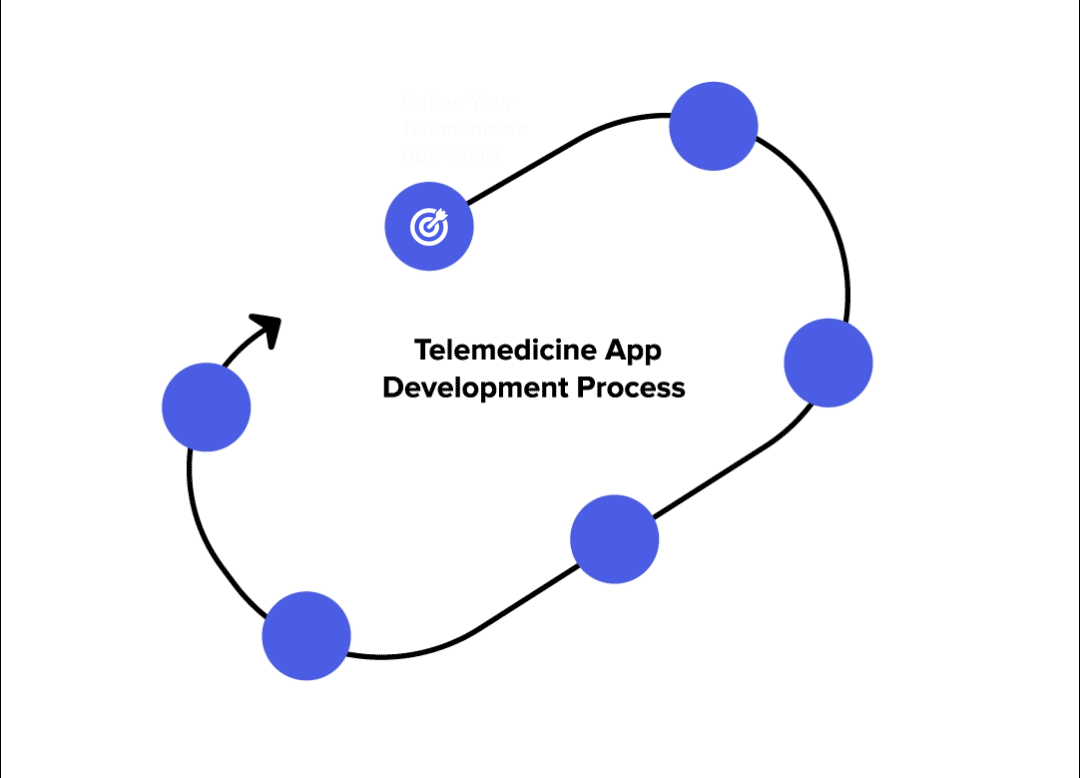
Define Your Telemedicine App Goals & Features
Start by outlining the app’s core purpose, whether it is for general consultations, mental health, or specialized medical care. Identify key features for patients (appointment booking, video calls, prescriptions), doctors (EHR access, scheduling, AI assistance), and admins (user management, billing, analytics). Understanding user needs helps in designing a feature-rich and efficient app.
Research Market & Compliance
Analyze market demand competitor applications and identify opportunities for differentiation. Healthcare apps must comply with strict regulations to protect patient data and ensure legal operations. The required compliance depends on the target region, such as HIPAA (USA), GDPR (EU), HITECH Act, and FDA/CE for medical devices.
Focus on the UI/UX Design
The app should be intuitive and user-friendly, catering to tech-savvy and non-tech users. Simple navigation, clear CTAs (Call-to-Actions), and an accessible design enhance usability. Ensuring dark/light modes, multi-device compatibility, and responsive layouts improves the experience for diverse users.
Develop & Integrate Core Features
Building essential features like user authentication, real-time video calls, EHR integration, and secure messaging is crucial. Integrating third-party APIs like Twilio (video calls), Stripe (payments), and Google Calendar (scheduling) ensures smooth functionality. Compliance with HL7 and FHIR standards is necessary for EHR connectivity.
Also Read: EHR Optimization Guide to Make Your Healthcare Offering Efficient
Test the Application
Thorough testing ensures a secure and smooth user experience. Unit testing checks each feature, integration testing verifies API connections, and security testing protects patient data. Usability testing with real users helps improve navigation and feature accessibility.
Deploy & Maintain
Once the app is tested, deploy it on Google Play Store and Apple App Store. Regular updates with bug fixes, security patches, and feature enhancements ensure smooth operation. Implement real-time monitoring with analytics tools like Google Analytics or Mixpanel to track user engagement.
Must-Have Features of Telemedicine Mobile Apps
Wondering about how to develop a telemedicine app? Let us help you out. When you partner with a telemedicine mobile app development company to build telemedicine applications for healthcare, you get two interfaces – one on the patient’s side and one on the physician’s side. While the feature sets for both stakeholders are more or less the same, some are specific to the doctors or physicians, like payment received and managing patients’ EHRs.
Let us look into the feature sets in detail as they highly impact the cost of a mobile telemedicine app.
Registration
The sign-in feature is the primary feature of any telehealth application. The patients can log in via email or third-party applications like Google sign-in or Facebook Login. However, noting how important it is to secure the data, we recommend adding multi-factor authentication to the application.
Profile Management
The next step for a user is to set up their profile. The patients’ profile can contain their basic health details, known health conditions, and treatment history. The telemedicine platform for doctors can contain details of their experience, contact information, the hospital they sit in, etc.
Search and Filters
Patients use the search algorithms in the telehealth apps to find the right doctors. With the help of the feature, they can look for doctors in their locality, in their preferred language, specialty, availability, and consultation fees.
Video Conferencing
Video chats are the prime feature of telemedicine mobile app development and the key factor in deciding the cost of a telemedicine platform. The video should be transmitted in high quality to ensure the physician can see the symptoms. At Appinventiv, our telemedicine app developers use streaming protocols like WebRTC and RTMP to enable seamless video chats.
Text Chats and Voice Calls
For small consultations, users prefer sending text messages or making voice calls from within the telehealth mobile apps. What helps in aiding this feature is allowing users to add photos and files of their medical data. As a telehealth app development company, it is important to ensure that the platform is hack-proof and follows HIPAA guidelines.
Calendar
A calendar is one of those features both patients and doctors use, enabling them to make appointments and keep track of it. We recommend syncing the calendar with the user’s one – Google Calendar or Microsoft Calendar, etc. This way, they will get notifications of when the appointment is due.
Payments
Another key feature of telemedicine applications for healthcare is the ease of making payments. As a telehealth app owner, you can decide between creating your payment mechanism or using a third-party payment app. Note that creating your payment model will increase the cost of telemedicine software while using a third-party solution will keep it on the lower side. At Appinventiv, we integrate payment gateways in your app, which are known in the industry as being robust – PayPal, Stripe, and Braintree.
Notifications
This is another feature that is the same for patients and a telemedicine app for doctors. It helps notify patients and doctors of their upcoming appointment, a new text message or missed video/voice call intimation, payment status, etc. To send push notifications, we generally use the Firebase Cloud Messaging platform.
Advanced Capabilities That Elevate Telemedicine App Performance
As telemedicine continues to evolve, integrating advanced features enhances the quality, efficiency, and accessibility of virtual healthcare. Let’s look at some of the top advanced features that enhance the performance of the telemedicine app.
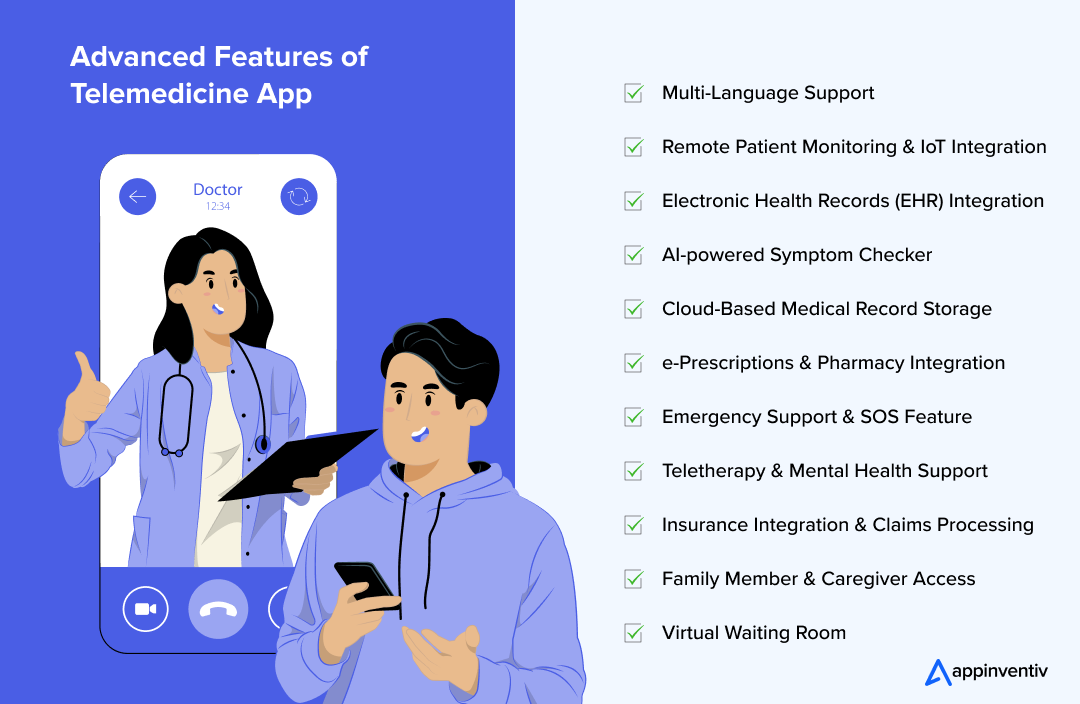
Multi-Language Support
For a truly global telemedicine experience, the app should support multiple languages. Real-time language translation for chats and consultations can eliminate communication barriers, making healthcare accessible to diverse patient groups.
Remote Patient Monitoring & IoT Integration
By integrating wearable and IoT-enabled medical devices, doctors can track vital signs such as heart rate, blood pressure, and glucose levels in real-time. Automated alerts notify doctors of abnormal readings, ensuring timely medical intervention for patients with chronic conditions.
Electronic Health Records (EHR) Integration
Doctors need seamless access to patients’ medical histories, lab reports, and prescriptions within the app. A secure telemedicine app integration with EHR enhances diagnostic accuracy, allowing for personalized treatment plans and streamlined patient care. Patients should also be able to upload past medical reports for easy reference.
Also Read: EMR Integration in Healthcare: Benefits, Features, & Costs
AI-powered Symptom Checker
An AI-driven symptom checker enables patients to input their symptoms and receive an initial health assessment. It can suggest possible conditions and recommend the right specialist, helping to reduce unnecessary doctor visits while improving self-care.
Also Read: 11 ways AI is transforming the telemedicine sector
Cloud-Based Medical Record Storage
A secure, encrypted cloud storage system allows patients and doctors to access medical histories, prescriptions, and lab reports anytime. HIPAA-compliant cloud storage ensures data privacy and security while enabling instant file sharing for remote consultations.
e-Prescriptions & Pharmacy Integration
Doctors should be able to generate, share, and send digital prescriptions directly through the app. Integration with local pharmacy chains allows patients to order medications instantly, ensuring quick refills and seamless prescription management.
Emergency Support & SOS Feature
An emergency button lets users instantly connect with emergency services or nearby hospitals during a critical health crisis. Patients can also share their real-time location with caregivers or medical responders for quick assistance.
Teletherapy & Mental Health Support
The app should offer one-on-one virtual therapy sessions, guided meditation tools, and anonymous chat-based counseling.
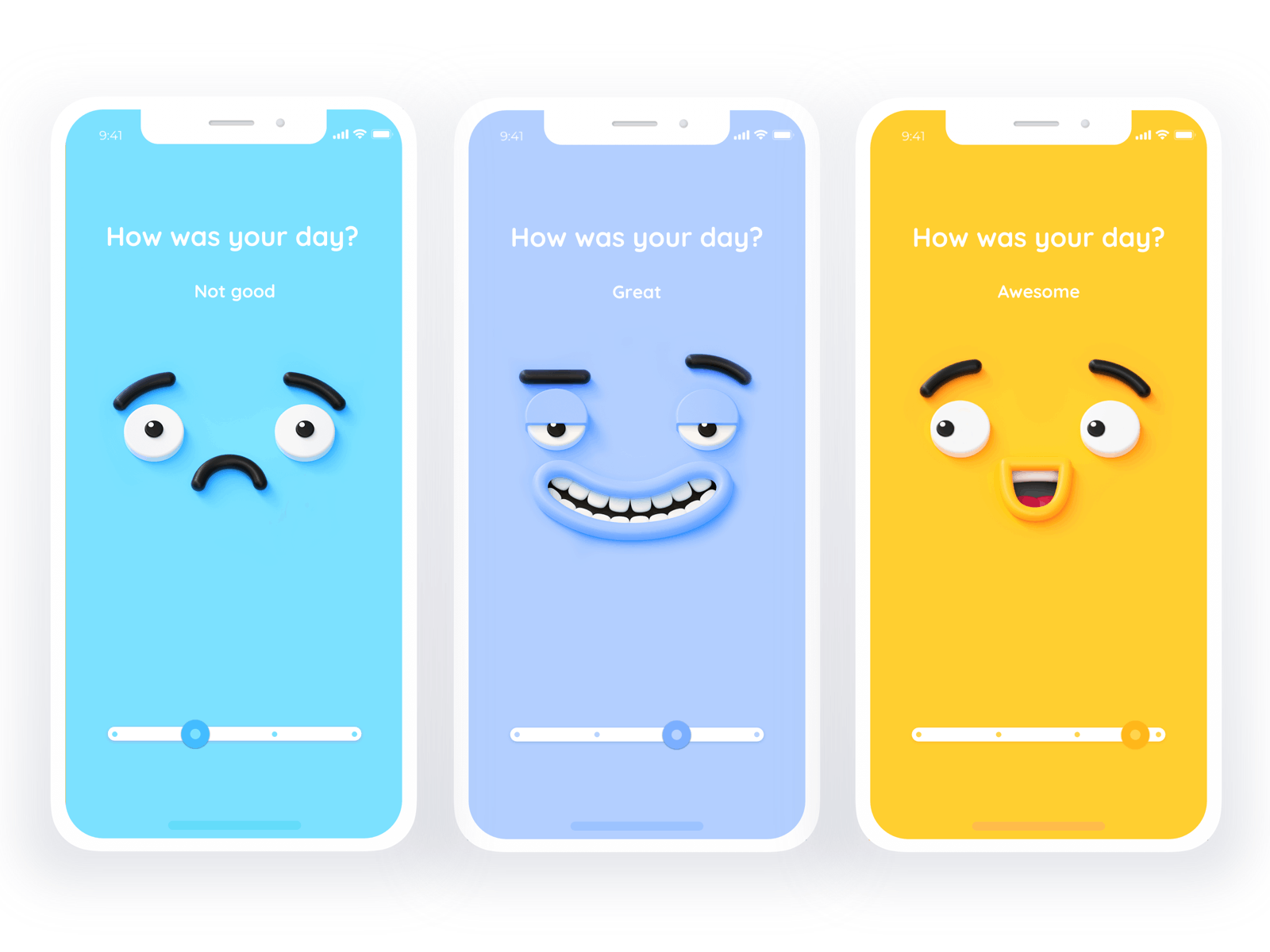
Mental health support ensures comprehensive telemedicine services catering to physical and emotional well-being.
Insurance Integration & Claims Processing
The app should allow patients to check insurance coverage, verify eligibility, and submit claims digitally. Seamless integration with insurance providers speeds up reimbursements, reducing financial burdens and making healthcare more accessible.
Family Member & Caregiver Access
Patients should be able to add family members or caregivers to their profile. This feature allows authorized individuals to book appointments, manage medications, and receive health updates on behalf of elderly or dependent patients.
Virtual Waiting Room
A virtual waiting room gives patients real-time updates on queue status and estimated wait times. This feature improves queue management for doctors and enhances patient experience by reducing uncertainty.
Having looked into the features of telemedicine platforms for doctors and patients, the next logical step would be to determine how you can monetize your telemedicine app.
How to Monetize a Telemedicine App?
Telemedicine apps bridge the gap between patients and doctors. Still, we have to take a business perspective and share all the details on how you can attract monetary benefits from your app. Deciding on the monetization strategies also depends on the telemedicine app development costs.
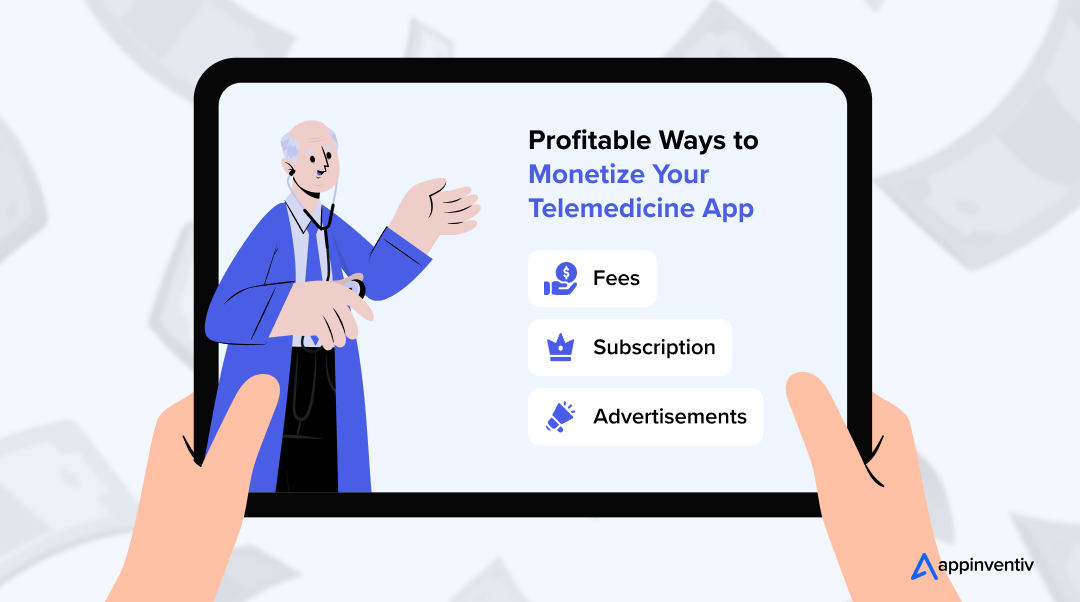
Fees
One of the most common ways of monetizing the telemedicine app is fees. In doctor on-demand app development, a revenue model is implemented where patients are charged a 25% fee to access features like doctor consultations. You can adopt a similar fee structure in your app to maintain a steady revenue stream while delivering essential healthcare services.
Subscription
You can also go with a membership model wherein the patients take a monthly subscription to the application and pay for accessing the different feature sets of the app at a discounted rate. Also, you can provide your product as a software-as-a-service where you can tie with corporations for their employees’ healthcare needs.
Advertisements
Usually, business owners offer their interactive app space for advertisements related to their niche. As soon as your app starts getting traction and retaining users, you can monetize with the help of generic advertisements displayed on your network.
With this, we have looked into the different facets of telemedicine platform costs. The only thing that remains is to enter the business.
How Can Appinventiv Help?
At Appinventiv, we specialize in healthcare application development services, crafting innovative telemedicine solutions that deliver measurable RoI. Whether you need precise cost estimates, strategic feature integration, or insights into market traction, our team ensures a seamless development process tailored to your needs.
One of our success stories, Health-e People, revolutionized healthcare connectivity by unifying fragmented medical data. The app empowers users to manage their health records while contributing to advanced research for breakthrough treatments.
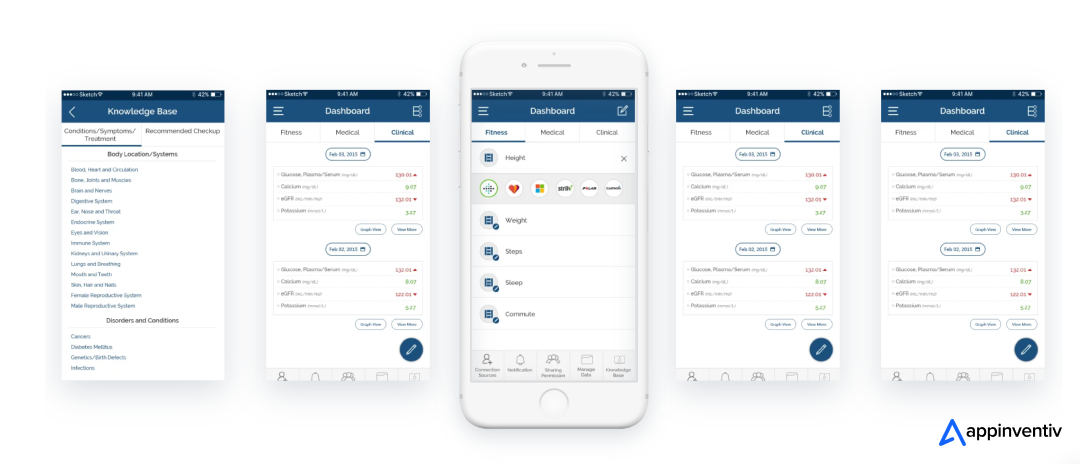
We created a solution that enhances patient care and scientific innovation by bridging gaps in the healthcare ecosystem. Similarly, we also worked on other healthcare projects like Soniphi and DiabeticU that justified our commitment to leveraging technology for better health outcomes.
By utilizing our comprehensive telemedicine app development services, the healthcare providers and startups can build future-ready digital solutions.
Share your telemedicine app idea, and we’ll transform it into a fully functional, high-performing solution.
Let’s collaborate to shape the next big thing in digital healthcare—contact us today!
FAQs
Q. How to make a telemedicine app for doctors?
A. A telemedicine app for doctors can be made from scratch by deciding on the app platform. Moving forward with an interactive UI/UX design and integrating all the features, a dedicated app development company can help you choose the right tech stack and cater to regulatory health compliances.
Q. How much does it cost to develop a custom telemedicine app?
A. The telemedicine app development cost varies based on features and complexity. A feature-rich telemedicine app can range from $100,000 to $300,000, while a basic app with minimal features and a simple UI/UX typically costs between $40,000 and $100,000.
Q. What are the basic inclusions in the MVP of a telemedicine app?
A. An MVP of a telemedicine app consists of a mobile or a web platform, HIPAA Compliance, separate panels for the patient, doctor, and admin, integrated payment gateways, and video and text chat capabilities.
Q. What are some top telemedicine app benefits for patients and healthcare organizations?
A. Here are some of the top telemedicine app benefits for both parties:
For Patients:
- On-demand healthcare access
- Reduced medical expenses
- Faster doctor consultations
- Seamless chronic disease management
For Healthcare Organizations
- Optimized operational efficiency
- Increased revenue opportunities
- Enhanced patient engagement
- Secure & compliant data management


- In just 2 mins you will get a response
- Your idea is 100% protected by our Non Disclosure Agreement.
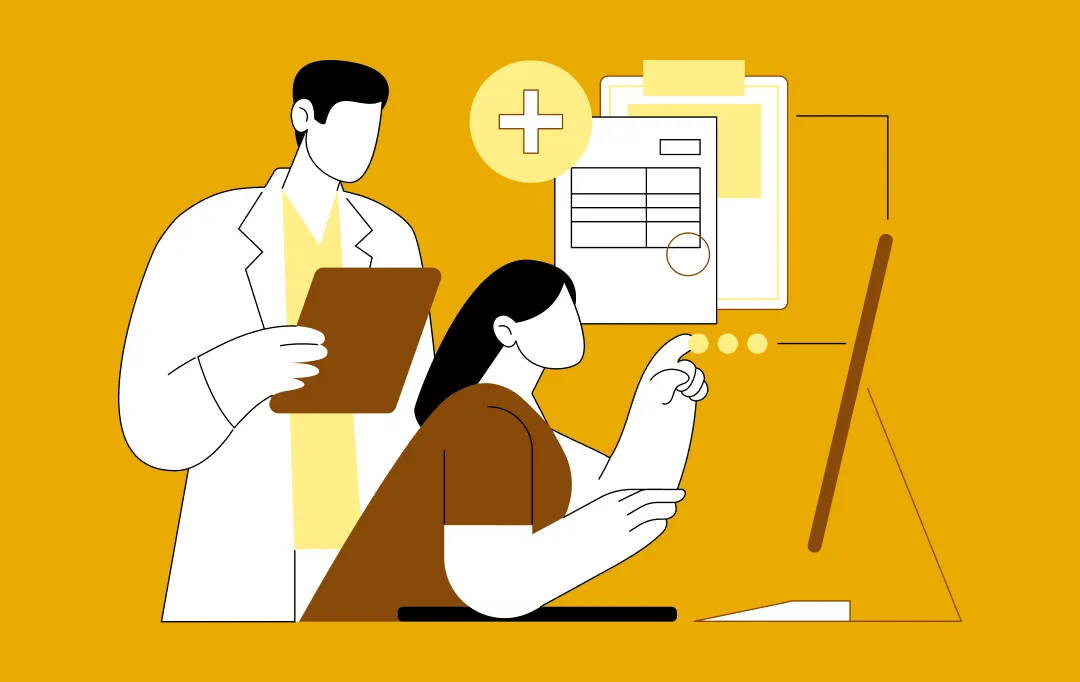
How Much Does It Cost to Build a Healthcare App in Saudi Arabia? All You Need to Know
Key takeaways: Healthcare app costs in Saudi Arabia range from 112,500 SAR to 2,250,000+ SAR based on size and complexity. The type of app you build matters more to cost than anything else. Compliance, security, and scalability are built into the cost, not add-ons. Development and testing consume the largest share of the budget. Hidden…
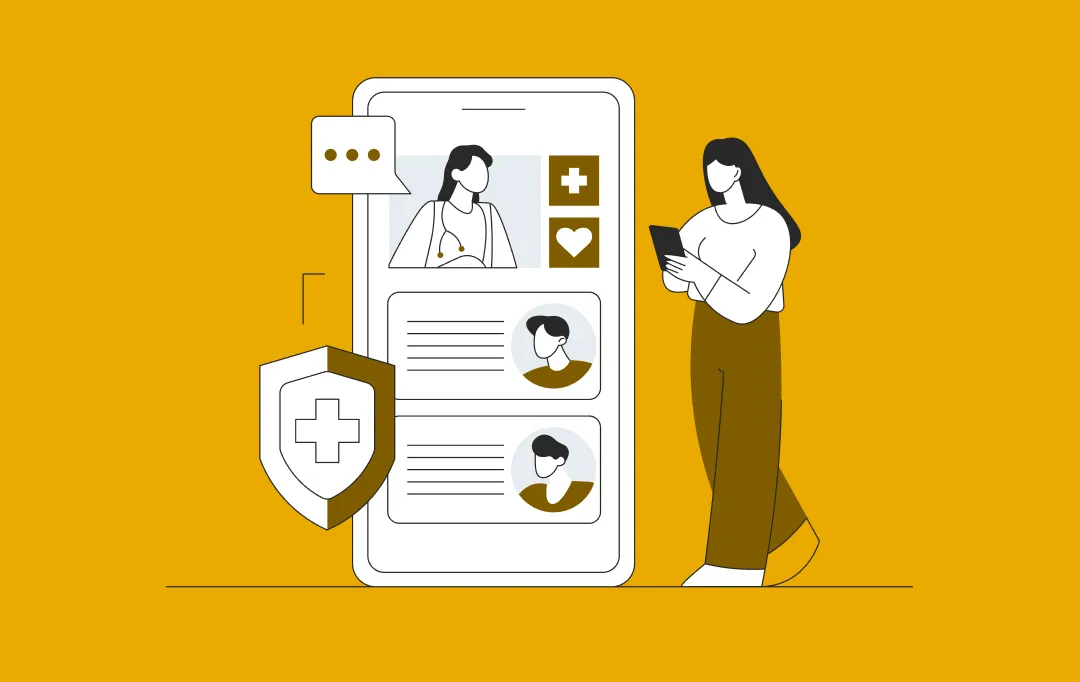
How Prescriptive Analytics Is Shaping the Future of Healthcare Management
A healthcare business doesn’t fall behind because its teams lack skill. It falls behind when decisions take too long. Bed allocation runs on yesterday’s data. Procurement reacts only when shortages hit. Care managers step in after a patient is already at risk. And leadership gets a picture of what’s happening only after the quarter closes,…
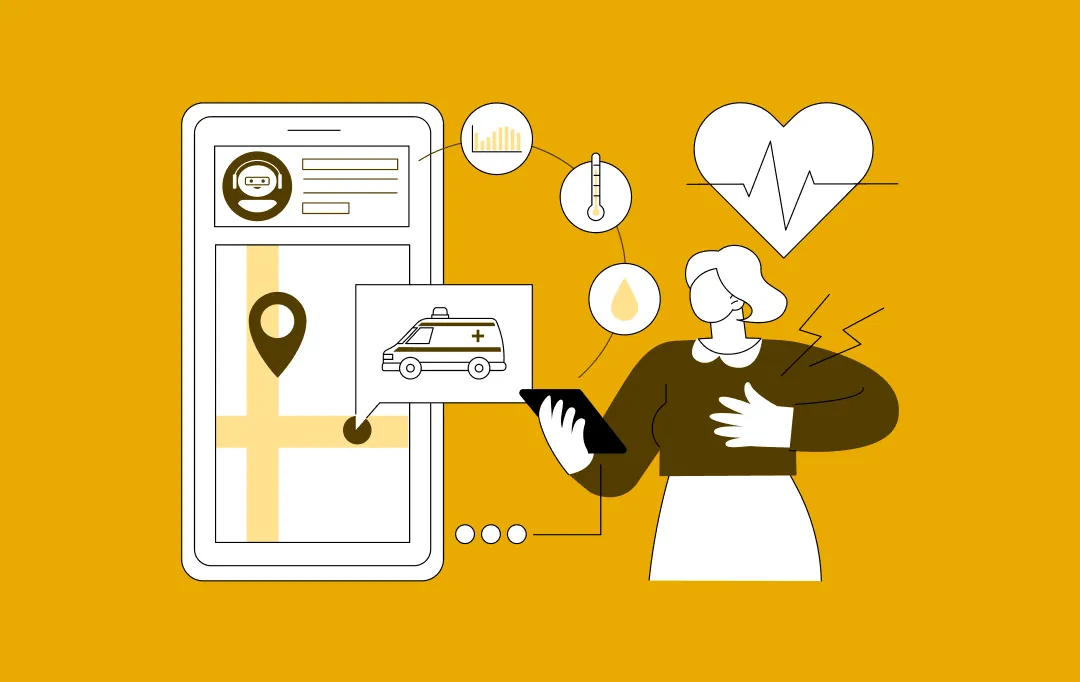
How to Build an Urgent Care App? A Step-by-Step Process, Features and Costs
Key takeaways: With more people turning to digital healthcare, the urgent care app market is expected to touch $3.1 billion by 2024 and continue growing fast through 2030. Apps that offer easy scheduling, video consultations, EHR access, and quick insurance handling tend to attract more users and keep them coming back. Developing an urgent care…








